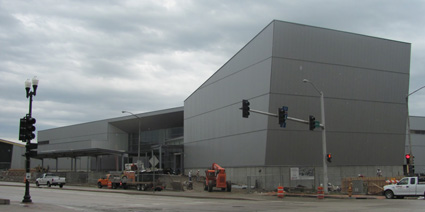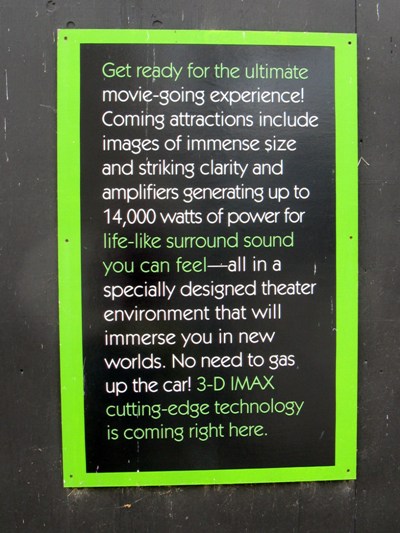The new Peoria Riverfront Museum opened last month, and a generous friend of mine gave me four free passes to encourage me to see it for myself. I took my kids on Saturday, Nov. 10, around 12:15 and we stayed until the museum closed at 5. It was fairly well-attended; I saw perhaps one to two hundred people while we were there.
The Exterior
We parked at Riverfront Village and walked across Water Street to the museum block. There is no entrance from Water Street, so visitors approaching from this side either have to circle the block or do what we did: climb the bare concrete stairs and cross the open space between the museum and the Caterpillar visitor center.
The pedestrian experience on Water Street is truly regrettable. The building is set back from the street over 100 feet. Between the street and the building is a berm, the aforementioned stairs, and the bare concrete air vents for the underground parking garage. Behind that — a half block away — the museum monolith rises above the landscape with its cold, gray, metallic siding.
Once you climb the stairs, there is a welcome surprise: the open space between the museum and Caterpillar visitor center is paved with bricks instead of concrete. Brick pavement provides a permeable membrane; that is, rainwater can pass between the bricks to the ground beneath, reducing runoff into the storm sewers. From the museum’s promotional material, it appears that water runoff is channeled to small gardens/plantings around the site.
The Entrance and the Theater
We entered the museum through the front doors that face Washington Street, through a large lobby, and up to the front desk. There were a lot of workers throughout the museum, and they were all very pleasant and helpful. We handed over our free passes and were each given a wristband that gave us access to all the exhibits and the planetarium, but not the “giant screen” theater. Had we paid for admission, it would have cost us $32.30 ($9.35 for adults, $7.65 for children) because we’re Peoria County residents and would enjoy a 15 percent discount. Normal price is $11 for adults and $9 for children.
I learned that the 15 percent discount for Peoria County residents does not apply to the “giant screen” theater. Everyone must pay full-price, which is $10 for adults and $8 for children. That came to $34 for me and my three children to see a 45-minute movie (“Sea Monsters: A Prehistoric Adventure” in 3D), plus the cost of popcorn and drinks. The museum workers really touted the size of the screen before starting the movie, specifically comparing it to the comparatively smaller IMAX theater at Rave Motion Pictures by the Shoppes at Grand Prairie. The museum group originally promised the public an IMAX theater that would show first-run Hollywood films, but then switched to a little-known brand (Global Immersion) showing primarily educational films once taxpayers had approved a referendum to help build the museum.
The screen was indeed very large (70 feet wide by 52 feet high), and the picture quality from the 4K (4096 x 2160 pixels) digital projector was superb. The audio system was designed by Legacy Audio, a manufacturer of high-end audio equipment. In fact, the president and founder of Legacy Audio, Bill Dudleston, actually designed this system specifically for integration with Global Immersion’s theater installations. I’ve heard Legacy speakers before because my uncle is an audiophile and used to sell their speakers. They have a very good reputation, and the sound in the theater was fantastic.
However, without the IMAX brand, and without first-run movies (or any Hollywood films, at present), this state-of-the-art theater is not going to draw many people. It’s a pretty hard sell to bring the family out for a 45-minute educational film at first-run theater prices. Fewer paid admissions means the museum will be hard-pressed to break even, given their pro forma operating budget.
The Exhibits
The museum is billed as “interdisciplinary,” and its mission is “to inspire lifelong learning for all — connecting art, history, science and achievement through collections, exhibitions and programs.” To that end, the museum includes the following exhibits: IHSA Peak Performance (achievement), “The Illinois River Encounter” (science), “The Street” and African American Wall of Fame (history), and International Feature Gallery (art). The planetarium and the aforementioned large-screen theater also add to the science portion (predominantly) of the museum.
We actually went to the theater later in the day. The first thing we did after getting our wristbands was to visit the Illinois High School Association’s Peak Performance gallery. It included a number of interactive displays that my kids thoroughly enjoyed. In fact, they could have spent the whole day in this one area and been content. We visited it about three times altogether. Their favorite displays were the ones where you see how high you can jump, how fast your reaction time is, how well you can balance, and how fast you can throw a baseball.
In the Illinois River Encounter, most of our time was spent in a room with a model of a river channel where you can manipulate sand and water to see how silt and sediment affects the flow of water down the river. The kids really enjoyed this interactive feature. My son also liked the display on the sinking of the Columbia, a steamboat that sank near Creve Coeur in 1918. There were several parts of the displays that were unfinished. For instance, there’s a small aquarium where fish from the Illinois river will be displayed, but it was not up and running yet.
Next, we went to “The Street” and, since I’m interested in Peoria history, I spent the most time here. The kids breezed through the exhibits pretty quickly, but spent most of their time in a side room with interactive displays that appeared to be designed to keep the kids occupied while adults looked at the exhibits. They looked at small objects through a high-powered microscope, put together model cars and raced them down a track, and fit magnetic gears together on a large board and spun them.
“The Street” was smaller than I expected and offered a pretty truncated view of Peoria’s history. As you enter and go to the left, there are four panels that cover Native American history of Peoria, French exploration of the area, the rise of the City, and then modern-day Peoria. About as brief of an overview as you can imagine. Again, there were several displays that were incomplete or not yet open. On the right as you enter there is a large display of Peoria’s distilling history and a display on the mass-production of penicillin at the ag lab. In the middle of the floor was an old Caterpillar engine and some historic bicycles.
Strangely, the really big Peoria history artifacts weren’t even in this area: the Duryea automobile that used to be housed at the Peoria Public Library was tucked away downstairs away from all the other exhibits and Jerry’s famous motorcycle boots we’re no where to be seen, and the old courthouse clock was perched above the stairway by the giant screen theater.
Tucked in another side room was an interactive computer display where you can look up information on famous Peorians like Richard Pryor and Betty Friedan. It wasn’t the easiest display to navigate and didn’t offer video or audio–just static images and a lot of text to read. The African American Hall of Fame is located here, too. Not exactly prominently displayed.
I also question some of the history. One display indicated that the “village” of Peoria was incorporated in 1831, then incorporated as a city in 1845. While the latter date is correct, I cannot find any history book that talks about Peoria being incorporated as a “village” and certainly not in 1831. The Town of Peoria was incorporated in 1835; perhaps that’s what they meant. In any case, it made me suspect of some of the other information that was presented.
We next went to the movie, then to the art gallery, which didn’t seem to have any particular theme. I had to laugh at one of the pieces of art — a watercolor painting of the museum. Seriously? There was another entire room that was unfinished; it still had ladders and bare drywall. If I had had to pay full admission, I would have been upset that so much of the museum was not yet complete.
Our final stop of the day was at the planetarium. I had wanted to see Stars of Peoria, but the time it was available was the same time as the giant-screen movie. So we instead saw the “Laser Vinyl” laser light show. The kids thought it was pretty cool overall, although my son fell asleep. They had never seen a laser show before. My oldest daughter even recognized some of the songs.
We checked out the museum store on our way out. Even though the museum was closing to the general public, it was just opening for a special showing to the Peoria Symphony Orchestra, complete with hors d’oeuvres in the lobby.
Final Thoughts
For a building that is so oddly shaped and sited, the inside was surprisingly squared off. The exhibit spaces were in rectangular rooms. It made me wonder why the exterior needed to be so sprawling and inefficiently sited. The displays could easily have been placed in a building that sat on a corner of the old Sears block and rose four or five stories. That would have been cheaper to build and would have opened the rest of the block to other, mixed uses — residential, retail, restaurants. Instead, the block is completely dedicated to the museum and the Cat visitor center, both of which close around 5 p.m., leaving the block empty and the street inactive.
For a building that looks so large from the outside, it felt surprisingly small on the inside. I was especially disappointed with the small amount of space dedicated to Peoria’s history. When talk of a downtown museum first started, it was originally envisioned to be a Peoria history museum. Over the years, it morphed into an “everything” museum, largely at the instigation of former congressman Ray LaHood. Unfortunately, the museum is now the proverbial “jack of all trades, master of none.” It’s like the diner that has every dish you can imagine on the menu, but doesn’t fix any of them particularly well.


